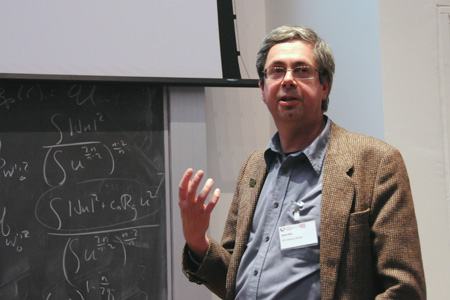A view from the Collaborations Workshop - Rob Allan
 The DevCSI project sponsored a number of key developers to attend the Collaborations Workshop. We hear from one of these developers, Rob Allan (pictured right), who talks about his experience of the workshop.
The DevCSI project sponsored a number of key developers to attend the Collaborations Workshop. We hear from one of these developers, Rob Allan (pictured right), who talks about his experience of the workshop.
I had known about the work of the Software Sustainability Institute for some time. I found out about the Collaborations Workshop from Neil Chue-Hong and Tim Parkinson who are involved in JISC-funded National e-Infrastructure for Social Simulation (NeISS) project, which I work on. I wanted to tell people about how we are using Sakai in NeISS to build Web interfaces for collaboration in private social networks, which also support Grid based data-management tools, simulation and workflow. I also wanted to represent the work of our department in supporting open-source development and the proposed Hartree Centre. So I registered for the workshop and somewhat to my surprise was chosen to receive a DevCSI award.
I was at the CRIB project review meeting in Lancaster on 2nd March - another project using Sakai, this time for managing networks of interacting researchers from business and management schools working with owner managers of small companies. So I was already on my way to Edinburgh and continued up in the evening. I met Hugh Glaser and a few other residents in the hotel bar. This was the first of a number of very stimulating conversations.
At the start of the first morning I put up a poster about the work of the Hartree Centre and gave a lightening talk. Among other things, I mentioned the Collaborative Computational Projects, which since 1979 have brought together groups across the UK to develop and sustain research software in a variety of science and engineering domains. The CCP model is successful in the UK, but software development is always tensioned against novel research, making sustainability hard. I also met colleagues over coffee - David Worth, Bryan Matthews and Neil Geddes from the Rutherford Lab. It turned out that I knew about half of the attendees as I have worked in e-Science for around 7 years (and wrote a book about my experiences). Hugh found it fun to chase down my other publications and network of colleagues from that period using his on-line linked data tools.
I participated in some breakout groups including the following. In the CRMs breakout, I explained our use of the Sakai groupware and social networking tools in addition to CRMs. At What are the benefits of collaboration?, I discussed the difficulties of managing large collaborations, particularly those with multiple sites or at an EU level. Smaller collaborations bringing together different skills to tackle a problem can be very beneficial. Some are unexpected but productive.
We were also going to have a breakout session on training Ph.D. students in programming methods, but there wasn't time to schedule it. I would have been interested in this as I am a partner in a collaboration recently funded by EPSRC to deliver short course for Ph.D. students on High Performance Computing which will cover this and some related topics.
I think one of the most significant statements of the day, actually from Mahendra Mahey's talk, was 'if you out source development, you don't have innovation'. Personally I believe that innovation is a key component of research, especially if we want to realise the potential impacts. That is as true in using software as in any other research methodology. Development should not be prescriptive. We want to bring together successful and focussed collaborations linking innovative software engineers with users in challenging research areas.
Thanks once again to the team at NeSC for their hospitality - it is always a pleasure to visit Edinburgh.
